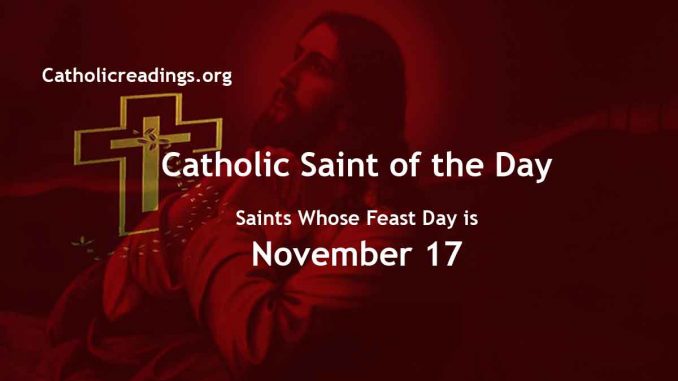This is the Saint of the Day list of Saints and Blesseds whose feast day is November 17 2025.
👉 St Elizabeth of Hungary, Religious
Saint Gregory Thaumaturgus
Saint Hugh of Lincoln
Saint Florinus of Remüs
Saint Hilda of Whitby
Saint Aignan of Orléans
Blessed Yosafat Kotsylovskyi
Saint Gregory of Tours
Saint Juan del Castillo Rodríguez
Saint Giacinto Ansalone
Blessed Salomea of Galicia
Blessed Sébastien-Loup Hunot
Saint Acisclus
Saint Victoria of Cordoba
Saint Lazarus Zographos
St Lazarus Zographos was also known as Lazarus the Painter, Lazarus of Constantinople, or Lazzaro. (Zographos means the painter.)
He was a monk at Constantinople and a skilled painter of icons. He opposed the Iconoclasts under emperor Theophilus, defended sacred images, and restored those that were defaced by Iconoclasts.
Because of his good works, he was arrested and tortured. Later on, the Iconoclasts fell from power and Lazarus was released and given a prominent place in the new regime, and eventually become the ambassador to Rome. He died in 867 AD.
Saint Thomas Hioji Nishi Rokuzaemon
St. Thomas Hioji Nishi Rokuzaemon was born in 1590 in Hirado, Nagasaki, Japan, and was also known as Father Thomas of St. Hyacinth.
He was a Dominican missionary priest first in Formosa and then in Japan. He was tortured and martyred in the persecutions of Tokugawa Yemitsu.
He died on November 17 1634 in Nishizaka, Nagasaki, Japan, and canonized on October 18 1987 by Pope John Paul II.
Saint Hugh of Novara
Saint Hugh of Novara was born in France and was also known as Hugo of Nucaria, Hugo of Noaria, or Ugo Hugh.
He has an additional memorial on 16th August in Novara, Sicily. He was a Cistercian Benedictine monk and a spiritual student of St Bernard of Clairvaux.
He served as the first abbot at the abbey in Novara, Sicily. He died in 1170 AD due to natural causes and is the patron saint of Bovara in Sicily.
Saint Eugene of Florence
St. Eugene of Florence was a spiritual student of St Ambrose of Milan. He was a deacon in Florence, Italy, working with St Zenobius of Florence. He died in 422 AD.
Saint Namasius of Vienne
St. Namasius of Vienne was also referred to as Naamat, Namaise, Namacio, Namat or Namatius. He was a bishop of Vienne in France. He died in 599 AD.
Saint Zacchaeus of Palestine
St. Zacchaeus of Palestine was tortured and martyred in the persecutions of Diocletian. He was beheaded in 302 AD and died in Palestine.
Saint Alphaeus of Palestine
St. Alphaeus of Palestine was tortured and martyred in the persecutions of Diocletian. He was beheaded in 302 AD and died in Palestine.
Martyrs of the Spanish Civil War
The martyrs of the Spanish Civil War were some of the thousands of people murdered from 1934 to 1939 during the Spanish Civil War anti-Catholic persecutions.
Their names are;
- Blessed Josefa Gironés Arteta
- Blessed Eusebio Roldán Vielva
- Blessed Lorenza Díaz Bolaños
Catholic Saint Feast Days in November

Powered By SEO Experts
Follow @ReadingCatholic
